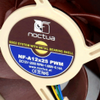Acoustic perfrormance
Acoustic performance - Fans Noise Levels
Right, we start off testing acoustics. Processors and graphics cards can produce a lot of heat, usually, that heat needs to be transported away from the hot core as fast as possible. Often you'll see massive active fan solutions that can indeed get rid of the heat, yet all the fans these days make the PC a noisy son of a gun. Do remember that the test we do is extremely subjective. We bought a certified dBA meter and will measure how many dBA originate from the PC. Why is this subjective you ask? Well, there is always noise in the background, from the streets, from the HDD, PSU fan, etc., so this is by a mile or two, an imprecise measurement. You could only achieve objective measurement in a sound test chamber.
The human hearing system has different sensitivities at different frequencies. This means that the perception of noise is not at all equal at every frequency. Noise with significant measured levels (in dB) at high or low frequencies will not be as annoying as it would be when its energy is concentrated in the middle frequencies. In other words, the measured noise levels in dB will not reflect the actual human perception of the loudness of the noise. That's why we measure the dBA level. A specific circuit is added to the sound level meter to correct its reading in regard to this concept. This reading is the noise level in dBA. The letter A is added to indicate the correction that was made in the measurement. Frequencies below 1 kHz and above 6 kHz are attenuated, whereas frequencies between 1 kHz and 6 kHz are amplified by the A weighting.
Our coustics tests we'll perform with the fans set up in three stages:
- Low performance - Fixed 4 volts + LNA adapter = Very Low operation
- Normal performance - Fixed 4 volts = Normal to low operation
- High performance - Fixed 12 volts = Extreme levels of operation
Noctua FLX (flexible) and ULN (ultra low noise) fan kits are based on the 3-pin power connector (not PWM). That means you can regulate them directly only by voltage (increasing or lowering voltage in say your BIOS or a fan controller). In certain conditions (fixed fan controllers and such) for the acoustics savvy among us, still want moar' silence. This is why Noctua includes the low Noise Adapter as shown above. Place it in between the fan and connector. You can but do not need to use it. We'll run a set of tests with this adapter installed (on all fans). Let's begin with some sheer silence.
Above the result set measured at ~40cm (a distance comparable in the real-world from your PC). Mind you, we deliberately place the fan onto a Noctua heat pipe cooler. We do this as when fan airflow hits things in its path, that's where noise is created! So I aimed this to be a realistic test. In any environment DBa perception is different. My guideline for fans/cooler is simple, anything 33 DBa you pretty much will not be able to hear under normal conditions. At ~4V voltage and the included Noise Adapter, anything is totally silent really. Of course, low RPM on your fans will have an adverse effect on temperatures and airflow, don't worry - we'll measure that as well and show results on the next pages.
Above, what we deem the nominal 4V setting. I proclaim this to be the generic 'default'. Your fans never spin at 12V (full RPM) unless you really need that. Most users also do not even have their fans configured at 50% voltage, typically they hit a 30 to 40% state in utilization. So most of the time you will be in the 3 to 5 Volts range. As you can see, all fans perform really good at this setting. They're all below my personal (and thus subjective) threshold of 33 DBa. The one fan passing that number is the P12 Redux, but that is a configured to be a high 1700RPM RPM fan, meaning it'll spin faster by default. The quick and raw generic conclusion here, all fans but one are silent under normally applied settings.
If your CPU is overheating or you are blasting that 16-core processor to the max - your fan RPM might ramp up towards 60, 80 even 100% Voltage ranges (depending on the quality and level of cooling/cooler). In such a scenario most fans will get much louder. This chart above reflects that, aside from two fans. The NF-A12x25 ULN and NF-P12 Redux 900 are low RPM configured fans, these will remain totally silent. That of course will have an adverse effect on airflow and thus performance as well. So for this page, the second chart (4V default) really is what your main focus should be, as that is the more and most representable metric for normal PC usage.







